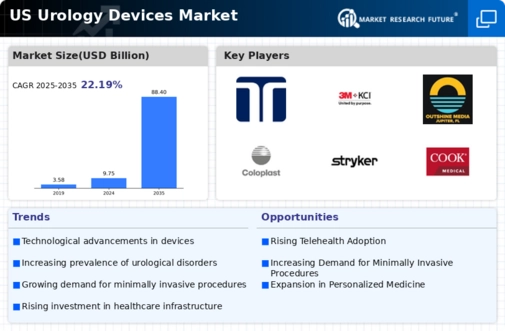The urology devices market is characterized by a dynamic competitive landscape, driven by technological advancements and an increasing prevalence of urological disorders. Key players such as Boston Scientific (US), Medtronic (US), and Johnson & Johnson (US) are at the forefront, each adopting distinct strategies to enhance their market presence. Boston Scientific (US) focuses on innovation, particularly in minimally invasive procedures, while Medtronic (US) emphasizes digital health solutions to improve patient outcomes. Johnson & Johnson (US) leverages its extensive portfolio to integrate advanced technologies into its urology devices, thereby enhancing operational efficiency and patient care. Collectively, these strategies contribute to a competitive environment that is increasingly centered around innovation and patient-centric solutions.
In terms of business tactics, companies are localizing manufacturing and optimizing supply chains to enhance responsiveness to market demands. The competitive structure of the urology devices market appears moderately fragmented, with several players vying for market share. However, the influence of major companies is substantial, as they set industry standards and drive technological advancements that smaller firms often follow.
In November 2025, Boston Scientific (US) announced the launch of a new line of advanced urology devices designed to improve surgical outcomes and reduce recovery times. This strategic move underscores the company's commitment to innovation and positions it to capture a larger share of the growing market for minimally invasive procedures. The introduction of these devices is likely to enhance patient satisfaction and operational efficiencies for healthcare providers.
In October 2025, Medtronic (US) unveiled a new digital platform aimed at streamlining urology device management and enhancing patient engagement. This initiative reflects the company's focus on integrating technology into healthcare solutions, potentially leading to improved patient outcomes and operational efficiencies. By leveraging digital health technologies, Medtronic (US) is likely to strengthen its competitive position in the market.
In September 2025, Johnson & Johnson (US) entered into a strategic partnership with a leading telehealth provider to enhance remote patient monitoring capabilities for urology patients. This collaboration is indicative of the growing trend towards digital health solutions and may significantly improve patient access to care. By integrating telehealth services with its urology devices, Johnson & Johnson (US) is poised to enhance its service offerings and strengthen its market position.
As of December 2025, current competitive trends in the urology devices market include a pronounced shift towards digitalization, sustainability, and the integration of artificial intelligence (AI) in product development. Strategic alliances are increasingly shaping the landscape, enabling companies to pool resources and expertise to drive innovation. Looking ahead, competitive differentiation is likely to evolve from traditional price-based competition to a focus on technological innovation, supply chain reliability, and enhanced patient outcomes. This shift suggests that companies that prioritize R&D and strategic partnerships will be better positioned to thrive in the evolving market.




















Leave a Comment